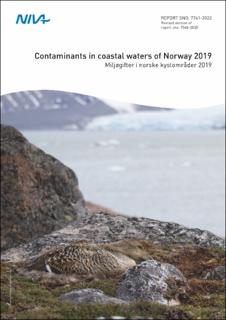| dc.description.abstract | This monitoring programme examines levels, trends and effects of contaminants in biota along the coast of Norway. The 2019- investigation included analyses of more than 176 different contaminants or biological effect parameters in six species (blue mussel, dogwhelk, common periwinkle, cod, flounder and common eider). The contaminants measured includes metals (Hg, Cd, Pb, Cu, Zn, Ag, As, Ni, Cr and Co), tributyltin (TBT), organochlorines (e.g. PCBs (PCB-7), DDT, HCB, OCS and QCB), PAHs, polybrominated diphenyl ethers (PBDEs), and perfluorinated alkylated substances (PFAS), as well as contaminants that have recently received much attention such as hexabromocyclododecane (HBCD), chlorinated paraffins (SCCP, MCCP) and siloxanes (D4, D5 and D6). Biological effects parameters includes the imposex parameter VDSI, OH-pyrene metabolites, ALA-D and EROD. In the report, 30 contaminants or biological effects parameters were chosen for statistical analyses of 670 time series (last 10 years). Of these, there were statistically significant trends in 100 cases: 72 were downwards and 28 upwards. The upward trends were associated with metals (67.9 %), primarily Cr (14.3 %). The downwards trends for TBT-concentrations and effect parameter VDSI confirmed that the legislation banning the use of TBT has been effective. Of the 2019-medians (last year) for all 670 time series, there were 346 cases that could be classified against EQS, of which 232 (67.1 %) were below the EQS and 114 (32.9 %) were above the EQS. Of the 2019-medians for the 670 time series, 582 cases could be classified using Norwegian provisional high reference contaminant concentrations (PROREF). Of these, 407 were below PROREF and 175 exceeded PROREF: 82 by a factor of less than two, 51 by a factor between two and five, 31 by a factor between five and 10, four by a factor between 10 and 20, and seven by a factor greater than 20. Some cases warrant special concern, such as high concentrations of several organic contaminants in cod liver from the Inner Oslofjord. Results of analyses of stable isotopes of carbon and nitrogen are presented to investigate the role of food origin and trophic levels for observed concentrations of contaminants. Results from supplementary studies that investigated geographical trends in contaminants and trophic levels are also presented. | en_US |
